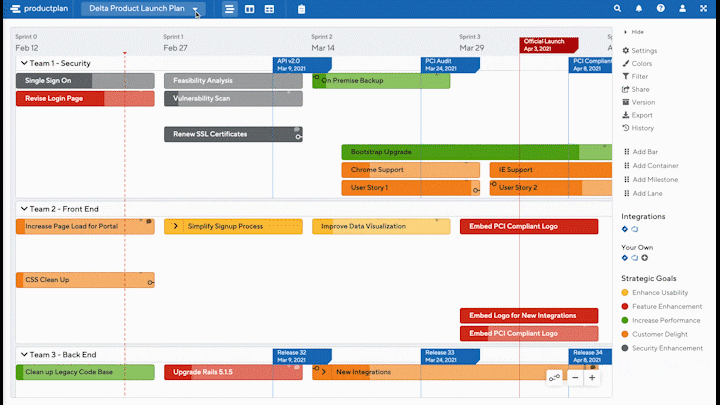A product roadmap is a high-level visual summary that maps out your product offering’s vision and direction over time. Building your first product roadmap is a multi-step process, as you will first need to determine your product vision and strategic goals.
In this post, we will walk you through the four basic steps of building your first product roadmap from scratch:
-
- Determine the “Why” for your product — it’s strategic reason for being.
- Determine your audience and tailor the roadmap to resonate with them.
- Prioritize your product’s strategic themes — and begin building the actual roadmap.
- Stay flexible — because your roadmap will change.
How to Build a Product Roadmap
Whether you’re new to product management or an experienced product manager who hasn’t had to build a new roadmap in a while, we know this undertaking can be so overwhelming you’re unsure how to take the first step. Knowing that the roadmap you create will eventually be viewed, scrutinized, and possibly debated over by stakeholders across your company and maybe even by your customers is intense.
As a company that has helped thousands of product managers develop and share their product roadmaps, we offer you the following high-level guide to creating a product roadmap from scratch.
Before we jump into that guide, though, if there is only one insight you take from this post, let it be this…
A product roadmap is not an operational to-do list. It is a strategic document designed to help you develop a plan for your product and keep your team on track executing that plan.
For many companies, the product roadmap is a unifying force for the entire organization and beyond. It serves as a microcosm for everything the company stands for, cares about, and works toward. It’s shared widely, referred to often, and used as a guidepost for everyone, from junior coders to sales executives to the C-suite.
The importance of audience
Making a product roadmap valuable, useful, and relevant for such a broad range of stakeholders requires an understanding of your audience, as well as their motivations.
You want your management team to see a roadmap that gives them confidence your product will help meet its strategic objectives. The sales team wants to see a roadmap that clearly shows them how they can convince prospects the product will meet their needs. Moreover, your developers want to see a roadmap that clearly explains what you’ll need from them and why their work will matter to the product’s ultimate success. When you have a roadmap meeting with your development team and want to know what you’re planning, your presentation needs to focus on what the product’s development will mean to them. For example, what technology you’ll be asking them to use, what timeframe they’ll have to get the work done, and what their day-to-day tasks and priorities will be.
Conversations with stakeholders
Having conversations with each type of stakeholder can uncover exactly what they care about and what they need to know about the product’s plans for the future. Armed with this knowledge, product management can create product roadmaps that fulfill these varied needs and expectations.
But building a product roadmap that serves that purpose for so many different types of people requires a few key things:
- Grounding the roadmap in its reason for being
- Organizational alignment around the product goals and measures of progress
- Optimized presentation of information for relevance and comprehension
It’s worth pointing out that when you build your static roadmap this way, you will need to manually update all versions of it every time priorities, dates, or other elements change in your development. Failing to update all versions of your static-document roadmap can quickly lead to version-control problems with the roadmap.
This is where visual product roadmapping tools separate themselves from other formats for communicating product plans. You need the ability to present different views and varying levels of detail, depending on the team or audience you’re presenting to. They have the flexibility and simplicity to work for everyone—without forgoing their usefulness for stakeholders requiring more detail.
Tweet This:
“A product roadmap is not an operational to-do list. It is a strategic document.”
It can be very tempting for a product manager in need of a roadmap to say, “I’ll just write out all of the themes, epics, and features we need for this product — and we’ll use that as our roadmap.” Although this sounds logical and easy to get something down on paper quickly, it will likely lead to all sorts of problems in your product development. You’ll see why as we walk through the guide below.
If you don’t have time to go through each step, download the guide below for future reference.
Building Your First Product Roadmap in 4 Steps
Updating existing roadmaps has its own set of challenges, but creating one from scratch is a tall order for any product manager. There’s so much to include it can be hard to know where to start.
1. Before you do anything else, determine the “Why” for your product — the strategic reason for being.
Why are you developing this product, which, in this way, prioritizes these product attributes for these users?
Those are the key strategic questions you need to ask yourself and your team at the outset of any new product development or update to an existing product. If you can’t answer those questions — ideally with data to support your answers — then you can’t reasonably justify spending any time and resources on the product at all.
It’s amazing how many product managers, even experienced and talented ones, skip this first step. Perhaps they assume they know the answers in their gut and don’t need to articulate them aloud or on paper clearly. Or maybe they’re just in a hurry to get a roadmap into a document because they have a stakeholder meeting coming up. But trust us — if you’re not prepared to answer these key strategic questions about your product’s reason for being, that stakeholder meeting will not go well for you.
Moreover, this first step will reward you in a major way throughout the development process and well beyond your product’s launch. Determining your product’s reason for being with your team upfront will make all of your downstream decisions more strategic and cohesive. Ultimately, it will lead to a more successful product.
Stakeholders need to understand your roadmap’s, “Why?”
When you can clearly articulate the “why” behind your strategic proposal for your product — and do so in a way that the roadmap communicates strategy how the product will contribute to the company’s strategic goals — you are much more likely to have your roadmap resonate with your stakeholders and earn their support to proceed. There are also a few other crucial conversations you need to have before starting your roadmap.

2. Determine your audience and tailor the roadmap to resonate with them.
This is another pitfall many product managers fall into. They create a single roadmap — often using a makeshift roadmap application such as spreadsheet or presentation software instead of using a purpose-built roadmap tool. (Here’s why improvised roadmap software is a bad idea.) Then these product managers present that roadmap to every team or group they meet with. That means their executives and investors see the same roadmap view that their developers see, and that same roadmap may even be shared with customers.
But remember, a product roadmap is a strategic document, and your strategic objectives in sharing it with your executives will vary wildly from your objectives in showing it to the marketing or development team.
Here’s a good rule of thumb. If you are using an identical roadmap document for every audience you present to, you will not be doing your job as a product manager. Why? Because when your executive stakeholders gather around your roadmap and say, “Show us what you’re planning,” they don’t want to see the ground-level details of every feature. They want to see how it will increase market share or mean to your revenue numbers for the next two quarters.
By contrast, when you have a roadmap meeting with your development team, and they want to know what you’re planning, your presentation needs to focus on what the product’s development will mean to them — what technology you’ll be asking them to use, what timeframe they’ll have to get the work done, and what their day-to-day tasks and priorities will be.
Product Roadmap Examples
I’ve shared an example below; here are three roadmap examples to help get you started. If you’re looking for a technology roadmap, these example technology roadmaps are useful. If you’re looking for a marketing roadmap, these example marketing roadmaps are great!

You want your management team to see a roadmap that gives them confidence your product will help meet its strategic objectives. You want your sales teams to see a roadmap that clearly shows them how they can convince prospects the product will meet their needs. And you want your developers to see a roadmap that clearly explains what you’ll need from them and why their work will matter to the product’s ultimate success.
What this means is that, in terms of your roadmap development, you have two choices. You can use a static document tool like a spreadsheet and then create several different versions of the same roadmap in spreadsheet format. (Again, bad idea.)
It’s worth pointing out here that when you build your roadmap this way, you will need to manually update all versions of it every time priorities, dates, or other elements change in your development. Failing to update all versions of your static-document roadmap can quickly lead to version-control problems with the roadmap files and people working on the wrong things.
Tweet This:
“Determine your audience and tailor the roadmap to resonate with them.”
Alternatively, you can use a purpose-built roadmap tool (like ProductPlan) to develop a dynamic and visual roadmap that will be easy to present at the right level of detail to the right audience.
3. Prioritize your product’s strategic themes — and begin building the actual roadmap.
At this point, you’ve set the foundation. You’ve determined your product’s strategic reason for being. And (we hope) you’ve found the right roadmap tool. Now it’s time to start typing.
So, where do you start? What goes onto the roadmap first?
Up to this point, you have approached every step in the roadmap creation process from a top-down, strategic point of view. You should use that same approach when building the actual details of your roadmap.
Start by determining what the major themes of the product will be. For each of those themes, create a swim lane on the roadmap. (Remember, if you’re using the right purpose-built roadmap tool, you can always move these themes around later with a couple of clicks or a drag-and-drop if you need to change the order of priority or move everything back in the timeline.)
Now that you have a series of major themes, you can start layering in epics beneath them. And if you determine you need additional detail, you can also layer in specific features beneath each epic.
You want to start at the strategic level with every detail you add to the roadmap. Just as you first determined your product’s reason for being, you’ll want to apply the same thinking to each theme, asking why that theme deserves a place on the roadmap — and which specific place it deserves in relation to the other themes, and why.
4. Stay flexible — because your roadmap will change.
Finally, as you’re building out the details on your roadmap, you’ll want to keep in mind that none of those details are set in stone. Companies’ priorities change. Resource levels change. Moves by competitors can force a product’s development or release schedule to change.
Tweet This:
“Stay flexible — because your roadmap will change.”
So you want to create your product roadmap — and present it to your various audiences — in such a way that leaves room for the inevitable updates, tweaks, and course corrections along the way.
And if you can tackle building your first roadmap strategically, and in the order, we’ve outlined here, you’ve got the makings of a successful product roadmap.
Annie Dunham, VP of Product at ProductPlan, shared quite a few more tips in this webinar on the key ingredients to successful roadmaps, which has even more information.
How to Build a Product Roadmap Takeaways
Building your first product roadmaps will vary to some degree, of course, but this should be a helpful starting point, a good list of items to keep in mind when hammering out your next product roadmap. You can standardize your process with collaborative, web-based roadmap software and convey the big picture in one place. ProductPlan lets you create and share beautiful roadmaps to build consensus across the entire organization.
We’ve also created a step-by-step template and checklist that explains how to do this in ProductPlan – download it below.




